Parable of the Prodigal Son
The Parable of the Prodigal Son (also known as the parable of the Two Brothers, Lost Son, Loving Father, or of the Forgiving Father)[1][2] is one of the parables of Jesus in the Bible, appearing in Luke 15:11–32.[lower-roman 1] Jesus shares the parable with his disciples, the Pharisees and others.
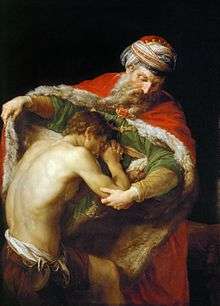
In the story, a father has two sons. The younger son asks for inheritance from his father, who grants his son's request. This son, however, is prodigal (i.e., wasteful and extravagant), thus squandering his fortune and eventually becoming destitute. As consequence, he now must return home empty-handed and intend to beg his father to accept him back as a servant. To the son's surprise, he is not scorned by his father but is welcomed back with celebration and a welcoming party. Envious, the older son refuses to participate in the festivities. The father tells the older son: "you are ever with me, and all that I have is yours, but thy younger brother was lost and now he is found."
The Prodigal Son is the third and final parable of a cycle on redemption, following the parable of the Lost Sheep and the parable of the Lost Coin. In Revised Common Lectionary and Roman Rite Catholic Lectionary, this parable is read on the fourth Sunday of Lent (in Year C);[3] in the latter it is also included in the long form of the Gospel on the 24th Sunday of Ordinary Time in Year C, along with the preceding two parables of the cycle.[4] In the Eastern Orthodox Church it is read on the Sunday of the Prodigal Son.
Narrative
_-_James_Tissot.jpg)
The parable begins with a man who had two sons, and the younger of them asks his father to give him his share of the estate. The implication is the son could not wait for his father's death for his inheritance, he wanted it immediately. The father agrees and divides his estate between both sons.
Upon receiving his portion of the inheritance, the younger son travels to a distant country and wastes all his money in extravagant living. Immediately thereafter, a famine strikes the land; he becomes desperately poor and is forced to take work as a swineherd. (This, too, would have been abhorrent to Jesus' Jewish audience, who considered swine unclean animals.) When he reaches the point of envying the food of the pigs he is watching, he finally comes to his senses:[lower-roman 2]
And when he came to himself, he said, How many hired servants of my father's have bread enough and to spare, and I perish with hunger! I will arise and go to my father, and will say unto him, Father, I have sinned against heaven, and before thee, and am no more worthy to be called thy son: make me as one of thy hired servants. And he arose, and came to his father. But when he was yet a great way off, his father saw him, and had compassion, and ran, and fell on his neck, and kissed him.
— Luke 15:17–20, KJV
This implies the father was hopefully watching for the son's return.
In most versions of Luke, the son does not even have time to finish his rehearsed speech,[5] as the father calls for his servants to dress him in a fine robe, a ring, and sandals, and slaughter the "fatted calf" for a celebratory meal.
The older son, who was at work in the fields, hears the sound of celebration, and is told about the return of his younger brother. He is not impressed, and becomes angry. He also has a speech for his father:[lower-roman 3]
And he answering said to his father, Lo, these many years do I serve thee, neither transgressed I at any time thy commandment: and yet thou never gavest me a kid, that I might make merry with my friends: but as soon as this thy son was come, which hath devoured thy living with harlots, thou hast killed for him the fatted calf.
— Luke 15:29–30, KJV
The parable concludes with the father explaining that because the younger son had returned, in a sense, from the dead, celebration was necessary:[lower-roman 4]
It was meet that we should make merry, and be glad: for this thy brother was dead, and is alive again; and was lost, and is found.
— Luke 15:32, KJV
Context and interpretation
%2C_Koninklijk_Museum_voor_Schone_Kunsten_Antwerpen%2C_781.jpg)
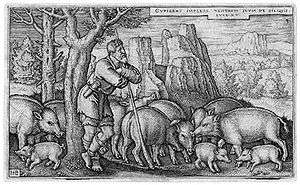
The opening, "A man had two sons" is a storyteller's trope and would immediately bring to mind Cain & Abel, Ishmael & Isaac, and Esau & Jacob. Jesus then confounds the listeners' expectations when the younger son is shown to be foolish.[6]
While a number of commentators see the request of the younger son for his share of the inheritance as "brash, even insolent"[7] and "tantamount to wishing that the father was dead,"[7] Jewish legal scholar Bernard Jackson says "Jewish sources give no support to [the idea] that the prodigal, in seeking the advance, wishes his father dead."[6]
The young man's actions do not lead to success, he squanders his inheritance and he eventually becomes an indentured servant, with the degrading job of looking after pigs, and even envying them for the carob pods they eat.[7] This recalls Proverbs 29:3: "Whoever loves wisdom gives joy to his father, but whoever consorts with harlots squanders his wealth."[lower-roman 5]
Upon his return, his father treats the young man with a generosity far more than he has a right to expect.[7] He is given the best robe, a ring for his finger, and sandals for his feet.[lower-roman 6] Clothing in the Bible may be symbolic of a character's change in status (see Biblical clothing). In this instance, clothing and accessories represent his rebirth ("was dead and is alive again") and newfound state ("was lost and is found"[lower-roman 7]).[8] Jewish philosopher Philo observes:[6]
Parents often do not lose thought for their wastrel (asoton) children.… In the same way, God too…takes thought also for those who live a misspent life, thereby giving them time for reformation, and also keeping within the bounds His own merciful nature.
The Pesikta Rabbati has a similar story:[6]
A king had a son who had gone astray from his father on a journey of a hundred days. His friends said to him, 'Return to your father.' He said, 'I cannot.' Then his father sent word, 'Return as far as you can, and I will come the rest of the way to you.' So God says, 'Return to me, and I will return to you.'
The older son, in contrast, seems to think in terms of "law, merit, and reward,"[7] rather than "love and graciousness."[7] He may represent the Pharisees who were criticizing Jesus.[7]
The last few verses of the parable summarize the tale in accordance with the Jewish teaching of the two ways of acting: the way of life (obedience) and the way of death (sin).[9] God, according to Judaism, rejoices over and grants more graces to repentant sinners than righteous souls who don't need repentance.[10]
Following the Parable of the Lost Sheep and the Parable of the Lost Coin, this is the last of three parables about loss and redemption that Jesus tells after the Pharisees and religious leaders accuse him of welcoming and eating with "sinners."[11] The father's joy described in the parable reflects divine love:[11] the "boundless mercy of God,"[12] and "God's refusal to limit the measure of his grace."[11]
Commemoration and use
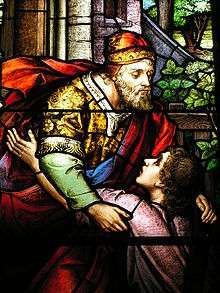
Orthodox
The Eastern Orthodox Church traditionally reads this story on the Sunday of the Prodigal Son,[13] which in their liturgical year is the Sunday before Meatfare Sunday and about two weeks before the beginning of Great Lent. One common kontakion hymn of the occasion reads:
I have recklessly forgotten Your glory, O Father;
And among sinners I have scattered the riches which You gave to me.
And now I cry to You as the Prodigal:
I have sinned before You, O merciful Father;
Receive me as a penitent and make me as one of Your hired servants.
Catholic
In his 1984 apostolic exhortation titled, in Latin, "Reconciliatio et paenitentia" ('Reconciliation and Penance'), Pope John Paul II used this parable to explain the process of conversion and reconciliation. Emphasizing that God the Father is "rich in mercy" and always ready to forgive, he stated that reconciliation is a gift on his part. He stated that for the Church her "mission of reconciliation is the initiative, full of compassionate love and mercy, of that God who is love."[14] He also explored the issues raised by this parable in his second encyclical, "Dives in misericordia" ('Rich in Mercy'), issued in 1980.[15]
In the arts
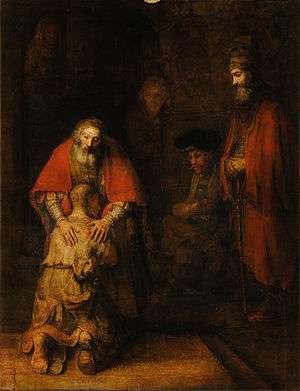
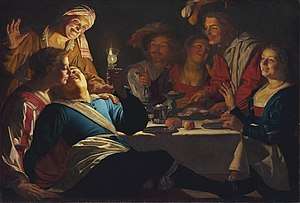
.jpg)
Art
Of the thirty-or-so parables in the canonical Gospels, this parable was one of four that were shown in medieval art—along with that of the Wise and Foolish Virgins, the Dives and Lazarus, and the Good Samaritan—almost to the exclusion of the others, though not mixed in with the narrative scenes of the Life of Christ.[16] (The Labourers in the Vineyard also appears in Early Medieval works.)
From the Renaissance, the numbers shown widened slightly, and the various scenes of the Prodigal Son—the high living, herding the pigs, and the return—became the clear favourite. Albrecht Dürer made a famous engraving, the "Prodigal Son amongst the Pigs" (1496), a popular subject in the Northern Renaissance. Rembrandt depicted several scenes from the parable, especially the final episode, which he etched, drew, or painted on several occasions during his career.[17] At least one of his works—i.e., "The Prodigal Son in the Tavern", a portrait of himself as the Son revelling with his wife—is, like many artists' depictions, a way of dignifying a genre tavern scene (if the title was indeed the original intention of the artist). His late "Return of the Prodigal Son" (1662–1669) is one of his most popular works.
"The Prodigal Son" is a sculpture in Harrisburg, Pennsylvania, by George Grey Barnard that depicts the loving reunion of the father and son from the "Parable of the Prodigal Son."[18]
Stage
In the 15th and 16th centuries, the theme was a sufficiently popular subject that the 'Prodigal Son play' can be seen as a subgenre of the English morality play. Examples include The Rare Triumphs of Love and Fortune, The Disobedient Child, and Acolastus.[19]
Notable adaptations for performance include:
- an 1869 oratorio by Arthur Sullivan;
- an 1880 opera by Amilcare Ponchielli;
- a 1884 cantata by Claude Debussy;
- a 1929 ballet choreographed by George Balanchine to music by Sergei Prokofiev;
- a 1957 ballet by Hugo Alfvén;[20] and
- an 1968 opera by Benjamin Britten.
Many of these adaptations added to the original Biblical material to lengthen the story. For example, The Prodigal (1955) film took considerable liberties, such as adding a temptress priestess of Astarte to the tale.[21]
Popular music
The parable is referenced in the last verse of the traditional Irish folk tune "The Wild Rover":
I'll go home to me parents, confess what I've done
and I'll ask them to pardon their prodigal son
"Jump Around" by the Los Angeles rap group House of Pain (1992) includes a verse by member Everlast, who references the parable as well as the Bible itself:
Word to your moms, I came to drop bombs
I got more rhymes than the Bible's got Psalms
And just like the Prodigal Son I've returned
Anyone stepping to me you'll get burned
Other references and semi-adaptations include:
- "Prodigal Son" by Reverend Robert Wilkins, which tells the story of the parable, is probably better known by the Rolling Stones cover version, which is featured on Beggars Banquet (1968).
- "Prodigal Man", written by Ted Nugent, was performed by The Amboy Dukes as the second track of their third album Migration (1969)
- "Let Me In" by The Osmonds presents a version of the parable as part of their Mormon concept album The Plan (1973), and was a hit song in its time.
- "Prodigal Son" by Steel Pulse, featured on the British Reggae band's debut album Handsworth Revolution (1979), recreates the Biblical story as a Rastafarian parable.
- "Prodigal Son" by British heavy-metal band Iron Maiden appears on their second album Killers (1981).
- "The First Time" by U2, featured on Zooropa (1993), is based on the parable but suggests an alternate ending to the story.
- "Make Me A Servant" by Kelly Willard (1982) could be argued as being based on what the son says to his father when he returns home.
- "The Prodigal Son Suite" by Keith Green is featured on his The Prodigal Son (1983) album and is one of the first posthumous releases by the late piano player and gospel singer.
- "When God Ran" by Benny Hester (1985), which is based on the parable, is another such song from the '80s Christian music scene.
- "Who Cares?" by Extreme was influenced by the parable and appears on the album III Sides to Every Story (1992).
- "Prodigal Son" by Kid Rock appears on his second album The Polyfuze Method (1993). The Detroit musician later re-recorded the track for his History of Rock (2000) compilation album.
- "She Walked Away" by BarlowGirl was influenced by the parable[22] and is featured on the Christian rock trio's 2004 self-titled album.
- "Said the son to the Father" by The Chinese Express is the opening song in After the Matinee (2005) as the first half of the two-part work featured in the album. The album closes with the second half, titled "Said the Father to the Son".
- "The Prodigal Son" by the "Indie" rock band, Two Gallants, as part of their What the Toll Tells (2006) album.
- "The Prodigal Son's Prayer" by country artist Dierks Bentley, featured on the album Long Trip Alone (2006), is based on the son's perspective of coming home after he's ruined himself in the world.
- "Please Come Home" by Dustin Kensrue is the titular song of the album of the same name released in 2007.[23]
- "Prodigal Son" by Bad Religion is featured on New Maps of Hell (2007).
- "Prodigal Son" by rock band Sevendust is featured on Chapter VII: Hope and Sorrow (2008).
- "Modern Day Prodigal Son" by Brantley Gilbert is featured on the album of the same name from 2009.
- "Prodigal Son" by Gideon appears on the post-hardcore band's second album Milestone (2012).
- "Prodigal Son" by Jamie's Elsewhere, a post-hardcore band.
- "Left Hand Free" by English indie rock band alt-J (2014) references the parable in the first verse.
- "Prodigal" by Sidewalk Prophets is included in the Christian band's Something Different (2015) album. The song is uplifting, with lyrics that are directed towards the titular Son from the parable, or any person who is or has felt like they are in a similar situation.
- "When the Prodigal Comes Home" by gospel artists Tribute Quartet (2016).
Literature
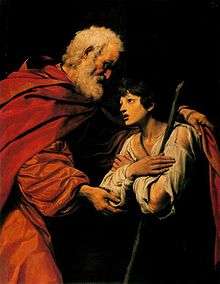
Another literary tribute to this parable is Dutch theologian Henri Nouwen's 1992 book, The Return of the Prodigal Son: A Story of Homecoming, in which he describes his own spiritual journey infused with understanding, based on an encounter with Rembrandt's painting that depicts the son's return. The book deals with three personages: the younger, prodigal son; the self-righteous, resentful older son; and the compassionate father—all of whom the author identifies with personally.[24] An earlier work with similarities to the parable is "Le retour de l'enfant prodigue" ('The Return of the Prodigal Son'), a short story by André Gide.[25]
Rudyard Kipling wrote a poem giving an interpretation of the younger brother's perspective. The poem appears as the heading to the fifth chapter, titled "The Prodigal Son", of his 1901 novel Kim.[26][27]
The Parable is a recurring theme in the works of Rainer Maria Rilke, who interpreted it in a different way to the conventional reading. Rilke's version is not so concerned with redemption and the forgiveness of family: the love of the family, and human love in general, was seen as less worthy than unreciprocated love, which is the purest form of love. In loving the family less, the Son can love God more, even if this love is not returned.[28][29]
The theme of the Prodigal Son plays a major role in Anne Tyler's novel A Spool of Blue Thread.[30]
The parable is also referred to in two comedies by William Shakespeare, specifically The Merchant Of Venice and As You Like It, as well as in Shakespeare's romance, The Winter's Tale.[lower-roman 8]
Similar parable in Mahayana Buddhism
A parable of a lost son can also be found in the Mahayana Buddhist Lotus Sutra.[31][32] The two parables are so similar in their outline and many details that several scholars have assumed that one version has influenced the other or that both texts share a common origin.[33] However, an influence of the biblical story on the Lotus sutra is regarded as unlikely given the early dating of the stratum of the sutra containing the Buddhist parable.[33]
Despite their similarities, both parables continue differently after the two meet for the first time at the son's return. In the biblical story, there is an immediate reunion of the two. In contrast, in the Lotus sutra, the poor son does not recognize the rich man as his father. When the father sends out some attendants to welcome the son, the son panics, fearing some kind of retribution. The father then lets the son leave without telling him of their kinship. However, he gradually draws the son closer to him by employing him in successively higher positions, only to tell him of their kinship in the end.[31] In the Buddhist parable, the father symbolises the Buddha, and the son symbolises any human being. Their kinship symbolises that any being has Buddha nature. The concealment of the kinship of the father to his son is regarded as a skillful means (Sanskrit: upāya).[34]
See also
- Ministry of Jesus
- Parable of the Workers in the Vineyard regarding the theme of God's unmerited grace, as distinguished from the idea of "earning" God's favour.
References
Verses
- Luke 15:11–32
- Luke 15:17-20
- Luke 15:29-30
- Luke 15:32
- Proverbs 29:3 (NRSV) – via Oremus Proverbs 29:3 (NABRE) – via U.S. Conference of Catholic Bishops
- Luke 15:22
- Luke 15:23
- Shakespeare, The Winter's Tale 4.4.89.
Citations
- "The Parable of the Lost Son." Holy Bible (New International Version). – via BibleGateway, Biblica, Inc. 2011 [1973].
- "Parable of the Forgiving Father (15:11-32)." Holy Bible (IVP New Testament Commentaries). – via BibleGateway. 2016.
- "Lent 4C". TextWeek.com. Retrieved 2013-09-12.
- "Proper 19 (24th Sunday of Ordinary Time)". TextWeek.com. Retrieved 2016-09-11.
- Nicoll, William R., ed. 1897. Luke 15:21 in Expositor's Greek Testament. New York: George H. Doran Company. Retrieved 20 May 2020. – via Bible Hub. Some ancient authorities complete verse 21 in line with the son's prepared statement.
- Levine, Amy-Jill. 25 August 2014. "What the Prodigal Son story doesn't mean." The Christian Century.
- Hultgren, Arland J. 2002. The Parables of Jesus: A Commentary. MI: Eerdmans Publishing. ISBN 0-8028-6077-X. pp. 70–82.
- Resseguie, James L. 2019. "A Glossary of New Testament Narrative Criticism with Illustrations" (full text). Religions 10(3): 217 29-30. doi:10.3390/rel10030217.
- Jewish Encyclopedia: Didache
- Kohler, Kaufmann, and Max Schlesinger. 2011 [1906]. "Repentance (Hebr. "teshubah")" Jewish Encyclopedia
- Longenecker, Richard N. 2000. The Challenge of Jesus' Parables. MI: Eerdmans. ISBN 0-8028-4638-6. pp. 201–13.
- Hahn, Scott, Curtis Mitch, and Dennis Walters. 2001. Gospel of Luke: The Ignatius Study Guide (2nd ed.). Ignatius Press. ISBN 0-89870-819-2. p. 51.
- "Scripture Readings Throughout the Year". Retrieved 2008-11-09.
- Catholic Church. 1998 [1984]. "Post-Synodal Apostolic Exhortation: Reconciliation and Penance of John Paul II." Vatican: Libreria Editrice Vaticana. ISBN 0-87973-928-2. pp. 234–39. Retrieved 20 May 2020.
- John Paul II. 1980. "Rich in Mercy" (encyclical). Vatican: Libreria Editrice Vaticana.
- Mâle, Emile. 1973 [1913]. The Gothic Image: Religious Art in France of the Thirteenth Century (1st ed.), translated by D. Nussey. London: Collins. ISBN 978-0064300322. p. 195.
- Fleischer, Roland E., and Susan C. Scott. 1997. Rembrandt, Rubens, and the art of their time: recent perspectives. US: Penn State University Press. ISBN 0-915773-10-4. pp. 64-65.
- Diana Strazdes, et al., American Painting and Sculpture to 1945 in the Carnegie Museum of Art, (New York: Hudson Hills Press, 1992), pp. 55-58.
- Craig, Hardin (1950). "Morality Plays and Elizabethan Drama". Shakespeare Quarterly. 1 (2): 71. doi:10.2307/2866678. ISSN 0037-3222.
- Don Michael Randel, The Harvard Biographical Dictionary of Music, Harvard University Press, 1996, ISBN 0-674-37299-9, pp. 13-14,
- Hammond, Paul. 2000. The shadow and its shadow: surrealist writings on the cinema (3rd ed.). San Francisco: City Lights Books. ISBN 0-87286-376-X. p. 70.
- BarlowGirl by BarlowGirl CD review at NewReleaseTuesday.com
- Dustin Kensrue at YouthMinistry.com
- LaNoue, Deirdre. 2000. The Spiritual Legacy of Henri Nouwen, Continuum. ISBN 0-8264-1283-1. p. 45.
- Turnell, Martin. "André Gide and the Disintegration of the Protestant Cell". Yale French Studies. Yale University Press (7): 21–31.
- Kipling, Rudyard. 2017 [1901]. "The Prodigal Son," edited with notes by P. Holberton. The Kipling Society. Also available via "Famous Poets And Poems. Retrieved 20 May 2020.
- Adam, Andrew K. M. 2001. Postmodern Interpretations of the Bible: A reader. Chalice Press. ISBN 0-8272-2970-4. pp. 202–03.
- Rilke, Rainer Maria. 2000 [1907]. "The Departure of the Prodigal Son." Pp. 41 in New Poems (bilingual ed.), translated by S. Cohn. Evanston, IL: Northwestern University Press.
- Rilke, Rainer Maria. 2008 [1910]. The Notebooks of Malte Laurids Brigge, translated by B. Pike. Champagne, IL: Dalkey Archive Press. p. 196.
- Sinkler, Rebecca Pepper (February 13, 2015). "Sunday Book Review: 'A Spool of Blue Thread' by Anne Tyler". The New York Times. Retrieved October 5, 2015.
- Kern, Johan H. C., trans. 2011 [1884]. "Disposition." Ch. 4 in Saddharma Pundarîka or the Lotus of the True Law, (Sacred Books of the East 21), edited by M. Müller. Oxford: Evinity Publishing. – via Internet Sacred Text Archive.
- Suzuki, Takayasu. 2015. "Two parables on 'The wealthy father and the poor son' in the 'Saddharmapundarika and the Mahaberisutra' (PDF)." Journal of Indian and Buddhist Studies 63(3):1263–70. doi:10.4259/ibk.63.3_1263. ISSN 1884-0051.
- Lai, Whalen W. 1981. "The Buddhist 'Prodigal Son': A Story of Misperceptions." Journal of the International Association of Buddhist Studies 4(2):91–98. ISSN 0193-600X
- Nhất Hạnh, Thích (2003). Opening the Heart of the Cosmos. Parallax Press. pp. 37–41. ISBN 9781888375336.
Further reading
- Brooks, David. 17 February 2014. "The Prodigal Sons." The New York Times.
- Cantalamessa, Raniero. 17 March 2007. "Comments on Fourth Sunday of Lent Readings." Zenit News Agency.
- Dimopoulos, George. 24 February 2008. "The Prodigal Son." Orthodoxy and the World.
- Holgate, David A. 1999. Prodigality, liberality and meanness in the parable of the prodigal son: a Greco-Roman perspective on Luke 15.11-32. Continuum. ISBN 1-84127-025-3.
- Horbury, Ezra. 2019. Prodigality in Early Modern Drama. Boydell & Brewer. ISBN 978 1 78744 606 9
- Morgan, G. Campbell. The Parable of the Father's Heart.
- Wiggins, James. 2010. What Did Jesus Teach? A Detailed Survey of His Parables. ISBN 978-1477699065.
- Di Rocco, E., ed. 2013. "Il romanzo della misericordia. La parabola del figliol prodigo nella letteratura." Studium 4(109).
- — 2013. "Leggere le Scritture con le Scritture: Ugo di Santo Caro e Nicola di Lira lettori di Luca (15, 11-32)." Studium 4(109).
- — 2014. "Il romanzo della misericordia. La parabola di Luca nella letteratura moderna e contemporanea." Studium 2(110).
- — 2014. "Heimkehr: wohin?, Auszug: wohin?: la parabola esistenziale del figliol prodigo nella letteratura del Novecento." Studium 2(110).
External links
